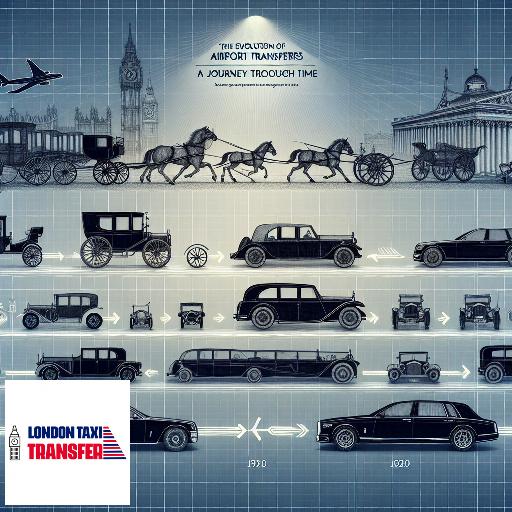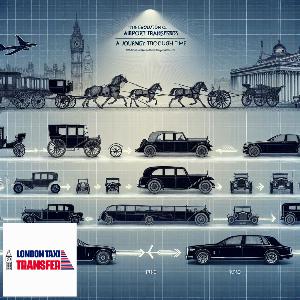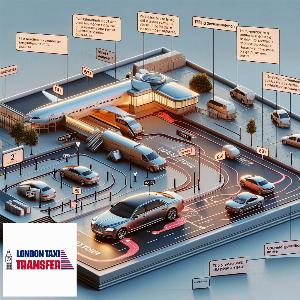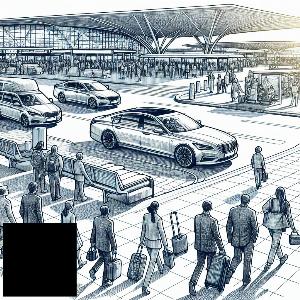The Evolution of London Airport Transfers: A Journey Through Time

Horse-Drawn Carriages to Motor Vehicles
The Evolution of London Airport Transfers: A Journey Through Time The history of London airport transfers is a fascinating tale of progress and innovation. In the early days, horse-drawn carriages were the primary mode of transportation for travelers making their way to and from the city's airports. These carriages, though charming, were limited by their pace and capacity, often resulting in long, arduous journeys. As the industrial revolution took hold, the advent of motor vehicles brought a transformative change to airport transfers. The introduction of motorized taxis and buses in the early 20th century marked a new era of efficiency and comfort for passengers. The speed and reliability of these vehicles allowed for quicker transit times and the ability to accommodate more travelers and their luggage. Today, London's airport transfer landscape is a dynamic mix of private cars, shuttles, and advanced public transport options, including the iconic black cabs and the extensive Underground network. Each evolution in transportation has contributed to a smoother, more accessible experience for visitors and residents alike, reflecting the city's continuous commitment to progress and modernity.
Introduction of the Motor Bus
Title: The Evolution of London Airport Transfers: A Journey Through Time The introduction of the motor bus revolutionized London airport transfers, marking a significant milestone in the city's transportation history. Before the advent of motorized buses, travelers relied on horse-drawn carriages or trains, which were often inconvenient and time-consuming. The early 20th century saw the emergence of the motor bus, offering a more efficient and flexible mode of transport for airport passengers. As London's airports expanded, so did the demand for reliable and accessible transfers. The motor bus filled this gap, providing a direct and cost-effective service to and from the bustling hubs of Heathrow, Gatwick, and beyond. The iconic red double-decker buses soon became synonymous with London's streetscape, enhancing the travel experience for both locals and tourists alike. Over the years, the motor bus has evolved with advancements in technology and comfort, adapting to the growing needs of a modern city. Today, London's airport transfer buses are equipped with amenities such as Wi-Fi, charging ports, and real-time tracking, ensuring a seamless journey for the contemporary traveler. The motor bus's introduction was not just a leap in transportation; it was a transformative step in the evolution of London's connectivity to the world.
Rise of the Black Cab
Title: Rise of the Black Cab: The Evolution of London Airport Transfers The iconic black cab has long been synonymous with London's bustling streets and has played a pivotal role in the evolution of airport transfers in the city. From the early days of horse-drawn carriages to the motorized taxis of the 20th century, the black cab has adapted to the changing needs of London's travelers. With the advent of motorized transport, the Hackney Carriage Act of 1831 laid the groundwork for the regulated taxi service we recognize today, ensuring safety and standardized fares for passengers. As air travel burgeoned post-World War II, London's airports became hubs of international movement, necessitating a reliable and efficient means of transport to and from the city. The black cab rose to the occasion, offering personalized door-to-door service with the added charm of the cabbie's local knowledge. Despite the rise of ride-sharing apps and modern shuttle services, the black cab remains a steadfast symbol of London's commitment to tradition and quality, continuing to be a preferred choice for many travelers seeking a quintessential London experience. As we look to the future, the black cab stands as a testament to the enduring legacy of London's airport transfers.
Expansion of Rail Networks
The evolution of London airport transfers is a testament to the city's commitment to progress and connectivity. Over the years, the expansion of rail networks has revolutionized the way travelers commute to and from London's bustling airports. In the early days, reaching airports like Heathrow or Gatwick was a journey fraught with traffic-laden roads and unpredictable travel times. The introduction of dedicated rail services such as the Heathrow Express in 1998 marked a significant shift, offering a swift 15-minute journey from Paddington Station to the heart of Heathrow. As the years progressed, the rail network continued to grow, weaving an intricate web of lines connecting the city to its air gateways. The Gatwick Express and the Stansted Express further streamlined airport transfers, providing fast and reliable alternatives to road transport. The crowning achievement came with the much-anticipated Crossrail project, now known as the Elizabeth Line, which promises seamless travel across London, significantly reducing transfer times to key airports. This journey through time highlights the transformative impact of rail network expansion on London's airport transfers, ensuring that the city remains at the forefront of global connectivity and travel convenience.
Advent of Airport Shuttles
The Evolution of London Airport Transfers: A Journey Through Time The landscape of London airport transfers has undergone a remarkable transformation over the years, evolving from the traditional black cabs and private hire vehicles to the advent of airport shuttles. This change marks a significant milestone in the journey of London's transport history. Airport shuttles have revolutionized the way travelers navigate between the city and its airports. With the introduction of these shuttles, passengers now enjoy a cost-effective, reliable, and efficient mode of transportation. The shuttles operate on a fixed schedule, providing frequent services that cater to the needs of both domestic and international travelers. The integration of airport shuttles into London's transport ecosystem has not only enhanced connectivity but also reduced congestion and the carbon footprint associated with airport transfers. As we look back on the evolution of airport transfers in London, the introduction of shuttles stands out as a testament to the city's commitment to innovation and customer satisfaction. This development has set a new standard for airport transportation, ensuring that London remains at the forefront of providing accessible and sustainable travel options for its residents and visitors alike.
Private Hire Vehicles and Minicabs
Title: The Evolution of London Airport Transfers: A Journey Through Time The landscape of London airport transfers has undergone a remarkable transformation over the years, with private hire vehicles (PHVs) and minicabs playing a pivotal role. In the early days, travelers arriving in London were met with a limited choice of transportation options, primarily consisting of black cabs and public buses. However, the introduction of PHVs and minicabs revolutionized the scene, offering a more personalized and convenient service. As the city expanded and air travel became more accessible, the demand for efficient and comfortable airport transfers surged. Enter the era of minicabs and PHVs, which provided a cost-effective and flexible alternative to traditional taxis. These services allowed passengers to pre-book their rides, ensuring a seamless connection from the airport to their final destination. With the advent of technology, booking a PHV or minicab has never been easier. Today, passengers can arrange their airport transfers with just a few taps on their smartphones, enjoying a hassle-free journey. The evolution of London's airport transfers, with PHVs and minicabs at the forefront, has not only enhanced the travel experience but also set a new standard for convenience and accessibility in urban transportation.
The Impact of the Tube
The Tube, London's iconic underground railway system, has played a pivotal role in the evolution of airport transfers in the city, marking a journey through time that has transformed the travel experience for millions. Since its inception, the Tube has expanded its network, connecting major airports like Heathrow to the heart of the capital with unprecedented ease. The introduction of the Piccadilly Line in 1977, directly linking central London to Heathrow, revolutionized airport transfers, offering a cost-effective and reliable alternative to taxis and buses. Over the years, the Tube's continuous upgrades have significantly reduced travel times and increased comfort, catering to the growing demands of international travelers. The Heathrow Express and the later addition of services to London City Airport further exemplified the Tube's impact, providing rapid transit for time-sensitive passengers. With the anticipated completion of the Elizabeth Line, the Tube's influence on airport transfers continues to shape the accessibility of London's airports, ensuring that the city remains a global hub for business and tourism. The Tube's journey through time is a testament to London's commitment to progress and innovation in public transport.
Rise of Ride-Hailing Apps
The Evolution of London Airport Transfers: A Journey Through Time The landscape of London airport transfers has undergone a remarkable transformation with the rise of ride-hailing apps. Gone are the days when travelers were limited to traditional black cabs or pre-booked minicabs. The advent of technology has revolutionized the way Londoners and tourists alike navigate the journey to and from the city's bustling airports. Ride-hailing apps, such as Uber and Bolt, have brought about a new era of convenience and efficiency. With just a few taps on a smartphone, passengers can now summon a ride that arrives within minutes, offering real-time tracking and estimated arrival times. This innovation has not only enhanced the travel experience but also introduced a competitive edge, prompting traditional taxi services to evolve and adopt digital booking systems. The integration of ride-hailing apps into the fabric of London's transport system reflects a broader shift towards a more connected and user-friendly city. As these platforms continue to grow, they promise to shape the future of airport transfers, ensuring that London remains at the forefront of modern, accessible transportation solutions.
Electric and Hybrid Transfers
The Evolution of London Airport Transfers: A Journey Through Time London's airport transfers have undergone a remarkable transformation over the years, evolving from the traditional black cabs and diesel-powered shuttles to the cutting-edge electric and hybrid vehicles of today. This shift reflects a broader commitment to sustainability and innovation in one of the world's most bustling metropolises. In the past, travelers arriving at Heathrow, Gatwick, or any of London's airports were greeted by a fleet of gas-guzzling cars, contributing to the city's carbon footprint. However, as environmental concerns took center stage, the transition to greener alternatives became imperative. Enter the era of electric and hybrid transfers, offering passengers a cleaner, quieter, and more energy-efficient journey into the heart of London. These eco-friendly vehicles are not only reducing emissions but also enhancing the overall travel experience. With the latest technology onboard, passengers can enjoy a smooth ride while contributing to a sustainable future. The evolution of London's airport transfers is a testament to the city's adaptability and dedication to progress, ensuring that the journey from the tarmac to the city is as green as it is grand.
Future Trends in Airport Transfers
As we embark on a journey through the evolution of London airport transfers, we witness a remarkable transformation from the classic black cabs and bustling shuttle buses to a future of seamless, technology-driven travel experiences. The future trends in airport transfers are poised to redefine convenience and efficiency for travelers navigating the sprawling metropolis. In the coming years, we can expect a surge in the use of electric and autonomous vehicles, reducing carbon footprints and providing passengers with a quiet, smooth ride to their destinations. Ride-sharing platforms will evolve, offering personalized routes and schedules that sync with flight times, minimizing wait periods and optimizing traffic flow. Artificial intelligence will play a pivotal role, with chatbots and virtual assistants facilitating real-time updates, booking amendments, and even language translation services for international travelers. Biometric verification will expedite security processes, allowing for swift, secure boarding of transfer vehicles. Moreover, the integration of smart infrastructure within London's transport hubs will enable a more interconnected travel ecosystem. Passengers will enjoy a unified, digital experience from the moment they land, with smart signage and mobile apps guiding them to their next mode of transport. As we look to the horizon, the evolution of London airport transfers is set to offer a harmonious blend of sustainability, innovation, and unparalleled passenger comfort, marking a new chapter in the city's rich history of transport.
Our Latest Blog Posts

The Evolution of London Airport Transfers: A Journey Through Time
Blog about The Evolution of London Airport Transfers: A Journey Through Time

Demystifying the Process of London Airport Transfers: An In-depth Analysis
Blog about Demystifying the Process of London Airport Transfers: An In-depth Analysis

Exploring the Convenience of London Airport Transfers
Blog about Exploring the Convenience of London Airport Transfers

The Art of Luxury in London Airport Transfers: A Unique Perspective
Blog about The Art of Luxury in London Airport Transfers: A Unique Perspective

London Airport Transfers: A Blend of Comfort and Efficiency
Blog about London Airport Transfers: A Blend of Comfort and Efficiency

Mastering the Art of London Airport Transfers: A Comprehensive Review
Blog about Mastering the Art of London Airport Transfers: A Comprehensive Review

Navigating the Intricacies of London Airport Transfers
Blog about Navigating the Intricacies of London Airport Transfers
Blogs Pages
Navigating the Intricacies of London Airport Transfers

Blog about Navigating the Intricacies of London Airport Transfers...
London Airport Transfers: A Blend of Comfort and Efficiency

Blog about London Airport Transfers: A Blend of Comfort and Efficiency...
The Evolution of London Airport Transfers: A Journey Through Time

Blog about The Evolution of London Airport Transfers: A Journey Through Time...
Demystifying the Process of London Airport Transfers: An In-depth Analysis

Blog about Demystifying the Process of London Airport Transfers: An In-depth Analysis...
Mastering the Art of London Airport Transfers: A Comprehensive Review

Blog about Mastering the Art of London Airport Transfers: A Comprehensive Review...
Exploring the Convenience of London Airport Transfers

Blog about Exploring the Convenience of London Airport Transfers...
The Art of Luxury in London Airport Transfers: A Unique Perspective

Blog about The Art of Luxury in London Airport Transfers: A Unique Perspective...


